Elasticity Of Demand
Elasticity Of Demand
Previously we discussed that the demand for a good depends on the price of the good, the price of other goods, income and tastes and quantity demanded changes with the change in these factors. The concept elasticity can be applied to determine how responsive the quantity demanded is to changes in each of these factors
Meaning of price elasticity of demand
Price elasticity of demand can be defined as responsiveness or sensitivity of the quantity demanded to price changes. Most goods have a downward-sloping demand curve and therefore have a negative price elasticity of demand. However there can be exception to this and demand curve of goods (Giffen goods) can have a positive price elasticity of demand. Demand for goods for which a change in price causes a more than proportionate change in the quantity demanded are said to elastic, in cases where the change in prices causes exactly proportionate change in quantity demanded the demand is said to be unit elastic and lastly the demand is said to be inelastic when a change in price causes a less than proportionate change in the quantity demanded
| Demand is said to be “elastic” when the (own price) elasticity of demand is more negative than –1 |
| Demand is said to have “unit elasticity” when the (own price) elasticity of demand is –1 |
| Demand is said to be “inelastic” when the (own price) elasticity of demand is less negative than –1 |
Kinds of price elasticity of demand
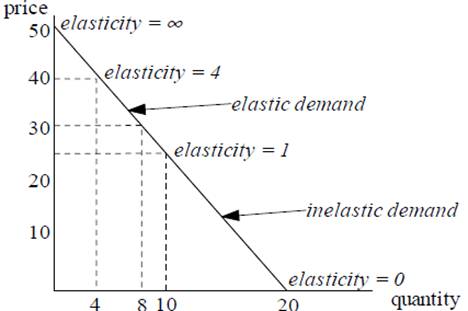
The elasticity of demand changes along the length of a demand curve. As we move along the demand curve from left to right, the percentage change in quantity demanded (calculated as change in quantity divided by original quantity) falls and the percentage change in price (calculated as the percentage change in price divided by original price) rises. Therefore elasticity decreases as we move from left to right. The figure above shows how elasticity changes along a straight-line demand curve. We can infer the following from the figure:
- elasticity falls as we move from left to right i.e. elasticity decreases as the price falls and the quantity demanded increases
- at the mid point of the demand curve the demand is unit elastic
- the demand is elastic above the midpoint
- the demand is inelastic below the midpoint
- demand is perfectly elastic where the quantity demanded is zero
- demand is perfectly inelastic where the price is zero
Measurement methods
Total outlay method or Revenue method
Total outlay method of measuring elasticity of demand was developed by Marshall. This method tries to measure change in total expenditure of the consumer or revenue of a firm due to change in the price of a good. Total outlay or total revenue is calculated as the multiplication of price and quantity demanded. This method expresses elasticity in three ways:
- Unitary elastic (E=1): Total revenue (outlay) remains unchanged as a result of price change
- Elastic (E>1): Total revenue (outlay) increases with fall in price and vice versa
- Inelastic (E<1): Total revenue (outlay) increases with rise in price and vice versa
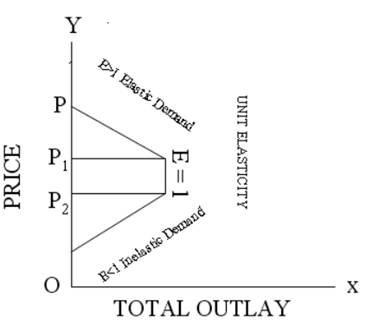
| Price ($) | Quantity demanded (units) | Total outlay (price x quantity) | Elasticity |
| 5 | 50 | 250 | |
| 6 | 45 | 270 | Inelastic (E<1) |
| 7 | 40 | 280 | Inelastic(E<1) |
| 8 | 35 | 280 | Unitary(E=1) |
| 9 | 30 | 270 | Elastic(E>1) |
| 10 | 25 | 250 | Elastic(E>1) |
Point method
Point method of elasticity refers to price elasticity of demand for a good / service at a point on the demand curve. This method is used to measure small change in quantity demanded due to small change in price. It is given as the ratio of the percentage change in quantity demanded of a good to its percentage change in the price. Thus Elasticity of demand = % change in Quantity demanded / % change in price
= ![]()
= ![]()
= ![]() *
*![]()
Arc method
When the elasticity is determined over a certain arc or section (i.e. between two given points) of the demand curve it is defined as arc elasticity. The elasticity is calculated as (% Change in Q)/ (% Change in P)
or EP = 
where;
Q1 is the initial quantity
Q2 is the final quantity
P1 is the initial price
P2 is the final price
This method helps elasticity as calculated to be same whether calculated from lower to higher or from higher to lower price. Thus a change from 8 to 10 and a change from 10 to 8 both result in the same percentage change
Income elasticity of demand
Income elasticity of demand is defined as the change in quantity demanded of a good due the change in the income of the consumer.
Income elasticity of demand of good “i” is ![]()
A normal good is a good for which the income elasticity of demand is positive. So the quantity demanded increases as income increases.
Normal goods can be categorised as follows:
- Income Inelastic normal good is also know as necessity. A necessity is a good for which the income elasticity of demand is less than 1. So a smaller proportion of a person’s income is spent on the good as income rises.
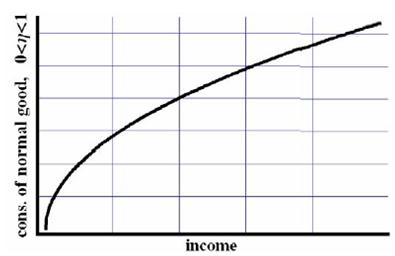
- Income Elastic normal good also known as luxury goods. A luxury is a good for which the income elasticity of demand is greater than 1. So a greater proportion of a person’s income is spent on the good as income rises.
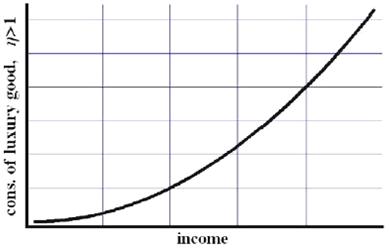
- Income Unit elastic normal good. The demand for these goods increase in the same proportion of the increase in the income level i.e. X% increase in the income leads to X% rise in the quantity demanded
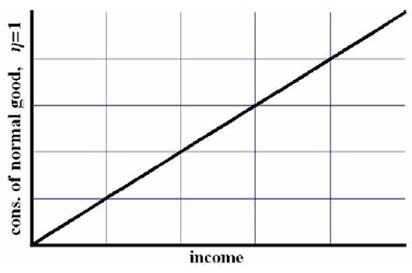
An inferior good is a good for which the income elasticity of demand is negative. So the quantity demanded falls as income increases.

Cross elasticity of demand
Cross elasticity of demand measures the sensitivity of the price change of a good to the quantity demanded of the other good (complement or substitute) all other things remaining same i.e. it tries to measure that if the price of a good increase (decreases) what is the percentage change in the quantity demanded of the other good
Goods can be classified as follows
- Complementary goods: These goods are jointly consumed, like petrol and car. These goods have negative cross elasticity of demand. For instance if the price of petrol increases the demand of cars will come down
- Substitute goods: These goods are alternatives to each other and the consumer can choose in between them. For instance a Toyota car and a Honda car. They tend to have positive cross price elasticity of demand. So if price of a Toyota car increases the demand for a Honda car would increase and vice versa.
Determinants of price elasticity of Demand
As discussed earlier price elasticity measures the responsiveness of the quantity demanded to a change in price of a product/good
The factors influencing the magnitude of the elasticity of demand are:
- Closeness of substitutes: The closer the substitute/alternative for the product, the higher elasticity of the demand will be for it
- Broadness of the product definition: It is easier to find substitutes for the product which is narrowly defined. For instance the demand for food is inelastic as there is virtually no substitute for food but Bread can be a substitute for meat
- Time elapsed since price change / length of the time considered: the longer the time has passed since the price change, the more elastic will be the demand. It is easier to find and make use of a substitute in the long run than in the short run. For example, if the price of domestic gas increases, the quantity demanded may fall a little as people try to use less gas for cooking and heating, but it may only be after a number of years, when people have had a chance to switch to electric cookers and, say, oil-fired central heating, that the full fall in the quantity demanded will occur
- The degree of brand loyalty / addiction: Some products have very strong brand loyalty, for example tickets to see an India – Pakistan cricket tie. Watching Australia-England match is not much of a substitute for an India/Pakistan fan! Some people are addicted to tobacco and are unlikely to reduce their demand for cigarettes very much if the price increases
- Proportion of the Income spent on the good: Other things remaining same, the greater the income spent on the good the more elastic is the demand for it. For instance if the price of a soap increase from $1 to $1.2 there will be hardy any fall in the demand of the same while if the price of a car increase from $5,000 to $6,000 there will be a significant fall in the price of that car
- The degree of necessity/luxury of the good: If the price of a necessity item such as milk or toothpaste increases there would be very little change in quantity demanded because consumers cannot do without these products and there is no real alternative. Some products are bought as treats such as bubble bath or boxes of chocolates and consumers would be inclined to go without or reduce their demand for this sort of product if the price increases and to treat themselves in some other way.
Microeconomics | Microeconomics Help | Elasticity Of Demand | Microeconomics Theories | Aggregate Demand | Law Of Demand | Elasticity Of Demand | Price Elasticity Of Demand | Elasticity Demand | Price Of Elasticity Of Demand | Price Elasticity | Inelastic | Online tutoring



